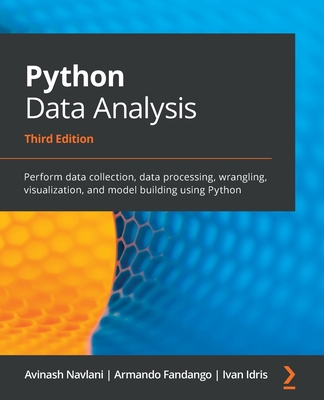Graph Machine Learning: Take graph data to the next level by applying machine learning techniques and algorithms
暫譯: 圖形機器學習:透過應用機器學習技術和演算法提升圖形數據的層次
Stamile, Claudio, Marzullo, Aldo, Deusebio, Enrico
- 出版商: Packt Publishing
- 出版日期: 2021-06-25
- 售價: $1,980
- 貴賓價: 9.5 折 $1,881
- 語言: 英文
- 頁數: 338
- 裝訂: Quality Paper - also called trade paper
- ISBN: 1800204493
- ISBN-13: 9781800204492
-
相關分類:
Machine Learning、Algorithms-data-structures
-
相關翻譯:
圖機器學習 (簡中版)
立即出貨 (庫存=1)
買這商品的人也買了...
-
 深入淺出 Java 程式設計, 2/e (Head First Java, 2/e)
深入淺出 Java 程式設計, 2/e (Head First Java, 2/e)$880$695 -
 數位影像處理使用 Matlab, 2/e (Digital Image Processing Using MATLAB, 2/e )
數位影像處理使用 Matlab, 2/e (Digital Image Processing Using MATLAB, 2/e )$790$774 -
 如何衡量萬事萬物:大數據時代,做好量化決策、分析的有效方法 (How to Measure Anything: Finding the Value of
如何衡量萬事萬物:大數據時代,做好量化決策、分析的有效方法 (How to Measure Anything: Finding the Value of$480$379 -
 TensorFlow + Keras 深度學習人工智慧實務應用
TensorFlow + Keras 深度學習人工智慧實務應用$590$460 -
 最成熟 AI 套件之實作:MatLab 人工智慧工具書
最成熟 AI 套件之實作:MatLab 人工智慧工具書$550$468 -
 Reinforcement Learning: An Introduction, 2/e (Hardcover)
Reinforcement Learning: An Introduction, 2/e (Hardcover)$1,750$1,715 -
 了不起的 Markdown
了不起的 Markdown$390$371 -
 $1,805Foundations of Deep Reinforcement Learning: Theory and Practice in Python (Paperback)
$1,805Foundations of Deep Reinforcement Learning: Theory and Practice in Python (Paperback) -
 大數據資料可視化:Python QT GUI 程式設計
大數據資料可視化:Python QT GUI 程式設計$880$695 -
 Introduction to Graph Neural Networks (Paperback)
Introduction to Graph Neural Networks (Paperback)$1,760$1,672 -
 生成深度學習|訓練機器繪畫、作曲、寫作與玩遊戲 (Generative Deep Learning)
生成深度學習|訓練機器繪畫、作曲、寫作與玩遊戲 (Generative Deep Learning)$580$458 -
 Efficient Processing of Deep Neural Networks (Paperback)
Efficient Processing of Deep Neural Networks (Paperback)$3,210$3,050 -
 Graph Representation Learning (Paperback)
Graph Representation Learning (Paperback)$2,250$2,138 -
 Reinforcement Learning|強化學習深度解析 (繁體中文版) (Reinforcement Learning: An Introduction, 2/e)
Reinforcement Learning|強化學習深度解析 (繁體中文版) (Reinforcement Learning: An Introduction, 2/e)$1,200$948 -
 Feature Engineering and Selection: A Practical Approach for Predictive Models
Feature Engineering and Selection: A Practical Approach for Predictive Models$2,250$2,138 -
 核心開發者親授!PyTorch 深度學習攻略 (Deep Learning with Pytorch)
核心開發者親授!PyTorch 深度學習攻略 (Deep Learning with Pytorch)$1,000$790 -
 $3,383Graph Neural Networks: Foundations, Frontiers, and Applications (Hardcover)
$3,383Graph Neural Networks: Foundations, Frontiers, and Applications (Hardcover) -
 MLOps 實踐 — 機器學習從開發到生產 (全彩)
MLOps 實踐 — 機器學習從開發到生產 (全彩)$636$604 -
 知識圖譜實戰
知識圖譜實戰$594$564 -
 $305知識圖譜:方法、工具與案例
$305知識圖譜:方法、工具與案例
商品描述
Build machine learning algorithms using graph data and efficiently exploit topological information within your models
Key Features:
- Implement machine learning techniques and algorithms in graph data
- Identify the relationship between nodes in order to make better business decisions
- Apply graph-based machine learning methods to solve real-life problems
Book Description:
Graph Machine Learning provides a new set of tools for processing network data and leveraging the power of the relation between entities that can be used for predictive, modeling, and analytics tasks.
You will start with a brief introduction to graph theory and graph machine learning, understanding their potential. As you proceed, you will become well versed with the main machine learning models for graph representation learning: their purpose, how they work, and how they can be implemented in a wide range of supervised and unsupervised learning applications. You'll then build a complete machine learning pipeline, including data processing, model training, and prediction in order to exploit the full potential of graph data. Moving ahead, you will cover real-world scenarios such as extracting data from social networks, text analytics, and natural language processing (NLP) using graphs and financial transaction systems on graphs. Finally, you will learn how to build and scale out data-driven applications for graph analytics to store, query, and process network information, before progressing to explore the latest trends on graphs.
By the end of this machine learning book, you will have learned essential concepts of graph theory and all the algorithms and techniques used to build successful machine learning applications.
What You Will Learn:
- Write Python scripts to extract features from graphs
- Distinguish between the main graph representation learning techniques
- Become well-versed with extracting data from social networks, financial transaction systems, and more
- Implement the main unsupervised and supervised graph embedding techniques
- Get to grips with shallow embedding methods, graph neural networks, graph regularization methods, and more
- Deploy and scale out your application seamlessly
Who this book is for:
This book is for data analysts, graph developers, graph analysts, and graph professionals who want to leverage the information embedded in the connections and relations between data points to boost their analysis and model performance. The book will also be useful for data scientists and machine learning developers who want to build ML-driven graph databases. A beginner-level understanding of graph databases and graph data is required. Intermediate-level working knowledge of Python programming and machine learning is also expected to make the most out of this book.
商品描述(中文翻譯)
使用圖形數據構建機器學習算法,並有效利用模型中的拓撲信息
主要特點:
- 在圖形數據中實現機器學習技術和算法
- 識別節點之間的關係,以便做出更好的商業決策
- 應用基於圖形的機器學習方法來解決現實問題
書籍描述:
《圖形機器學習》提供了一套新的工具,用於處理網絡數據並利用實體之間關係的力量,這些工具可用於預測、建模和分析任務。
您將從圖論和圖形機器學習的簡要介紹開始,了解它們的潛力。隨著進展,您將熟悉圖形表示學習的主要機器學習模型:它們的目的、工作原理以及如何在各種監督式和非監督式學習應用中實現。然後,您將構建一個完整的機器學習管道,包括數據處理、模型訓練和預測,以充分發揮圖形數據的潛力。接下來,您將涵蓋現實世界的場景,例如從社交網絡提取數據、文本分析和使用圖形進行自然語言處理(NLP)以及金融交易系統。最後,您將學習如何構建和擴展數據驅動的圖形分析應用,以存儲、查詢和處理網絡信息,然後進一步探索圖形的最新趨勢。
在這本機器學習書籍結束時,您將學到圖論的基本概念以及用於構建成功機器學習應用的所有算法和技術。
您將學到的內容:
- 編寫Python腳本從圖形中提取特徵
- 區分主要的圖形表示學習技術
- 熟悉從社交網絡、金融交易系統等提取數據
- 實現主要的非監督式和監督式圖形嵌入技術
- 掌握淺層嵌入方法、圖形神經網絡、圖形正則化方法等
- 無縫部署和擴展您的應用
本書適合誰:
本書適合數據分析師、圖形開發人員、圖形分析師和圖形專業人士,他們希望利用數據點之間的連接和關係中嵌入的信息來提升分析和模型性能。本書對於希望構建以機器學習驅動的圖形數據庫的數據科學家和機器學習開發人員也將非常有用。需要具備初級的圖形數據庫和圖形數據理解,並期望具備中級的Python編程和機器學習工作知識,以充分利用本書。






























